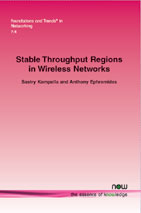Stable Throughput Regions in Wireless Networks
By Sastry Kompella, U.S. Naval Research Laboratory, USA, sastry.kompella@nrl.navy.mil | Anthony Ephremides, University of Maryland, College Park, USA, etony@umd.edu
Abstract
We present a review of the notion of stability and of stable throughput regions in wireless networks, with emphasis on network layer cooperation between interacting users. After a brief introduction, we examine in detail specific instances of the stability issue. These instances differ from each other in terms of the network, channel and traffic models they use. What they share is the notion of how stability is affected by node cooperation, as well as the notion of "interacting queues" that makes the stable throughput analysis difficult and often intractable. This review is intended to provide a reference point for the rich set of network control problems that arise in the context of queue stability in modern and future networks.
Stable Throughput Regions in Wireless Networks
Stable Throughput Regions in Wireless Networks examines the fundamentals of stable throughput in wireless networks. It reviews the notion of stability and of stable throughput regions in wireless networks, with emphasis on network layer cooperation between interacting users. After a brief introduction, it examines in detail specific instances of the stability issue. These instances differ from each other in terms of the network, channel and traffic models they use. What they share is the notion of how stability is affected by node cooperation, as well as the notion of “interacting queues” that makes the stable throughput analysis difficult and often intractable. This review is intended to provide a reference point for the rich set of network control problems that arise in the context of queue stability in modern and future networks.
